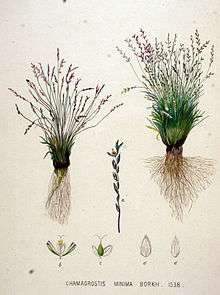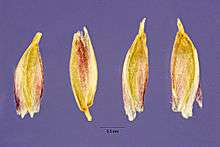Mibora minima
Mibora minima, the early sandgrass,[2] is a small (between 2 and 15 cm high) annual species of grass that is native in western and southwestern Europe.
| Mibora minima | |
|---|---|
| Dried Mibora minima specimen, 9 cm high | |
| Scientific classification | |
| Kingdom: | Plantae |
| Clade: | Tracheophytes |
| Clade: | Angiosperms |
| Clade: | Monocots |
| Clade: | Commelinids |
| Order: | Poales |
| Family: | Poaceae |
| Subfamily: | Pooideae |
| Genus: | Mibora |
| Species: | M. minima |
| Binomial name | |
| Mibora minima | |
| Synonyms[1] | |
|
List
| |
It is an invasive species on both sides of the Canada–United States border from Lake Huron east to Maine.
It grows on moist sand in open vegetations.[3]
Description

Etch from the Flora Batava

florets, 2nd from left facing up
Mibora minima is a small annual species of grass, with tufts of thin stems of about 0.3 mm wide and 10 cm long, each with 2 or 3 leaves at or very near the base, consisting of tender, shallowly grooved sheaths, rounded at their back, 0.2–1 mm long ligules, flat or enrolled blades of 1–5 cm long which are up to 0.5 mm wide and have a stump tip.[3]
gollark: Hmm. Is there anything stopping me pinning random software I didn't contribute to to my github profile?
gollark: ?tag create euboea Euboea is blazingly fast and small programming language compiled JIT to Machine code.
gollark: Oh, heavserver has that but for the moderator channels.
gollark: Also Miniflux.
gollark: Oh, I forgot wireguard.
References
- Mibora minima en PlantList
- "Mibora minima". Natural Resources Conservation Service PLANTS Database. USDA. Retrieved 28 January 2016.
- Editorial Committee of the Flora of North America (1993). Flora of North America: Magnoliophyta: Commelinidae (in part): Poaceae, part 1. Oxford University Press.
This article is issued from Wikipedia. The text is licensed under Creative Commons - Attribution - Sharealike. Additional terms may apply for the media files.